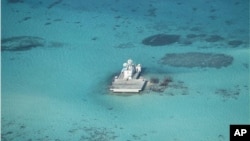New details about China's construction and land reclamation efforts in the South China Sea have spurred criticism from the United States and concern from the Philippines. But China continues to press forward, arguing the build up is lawful and does not impact or target any country.
A newly released unclassified report from the U.S. Office of Naval Intelligence, its first in six years, highlights the challenges the region is facing as Beijing carries out a massive naval buildup. China is expanding its number of warships and submarines with advanced guided missiles and carrying out a massive land reclamation effort around islands it controls in the South China Sea’s Spratly Islands.
The construction activity around seven reefs has seen land expand from about two hectares to more than 300 hectares, the study noted. There is now enough new land around the reefs for at least one airstrip and perhaps another by the end of this year.
The commander of the U.S. Pacific Command, Admiral Harry Harris recently warned that China is building a “great wall of sand,” near the disputed islands. He also said how Beijing proceeds will be a key indicator of whether the region is heading toward confrontation or cooperation.
But China says its intentions are peaceful. While it has not denied the military and strategic value of the buildup, it has instead focused on constructive roles the islands could play such as helping with weather forecasts and navigation aid. It also says the islands could serve as a safe harbor for ships in an area that is prone to marine accidents brought on by typhoons and monsoons.
Xiamen University’s Center for Southeast Asian Studies professor Li Jinming said China was actually behind others when it came to the building of structures.
Li said that “if you look at all of the other countries that occupy islands in the South China Sea, China is the only one that does not have an airstrip.” He added that when the Philippines and Malaysia built their airstrips no one spoke out, and yet now that China is playing catch up, neighboring countries are raising objections and protesting.
In addition to the Philippines and Malaysia, other claimants that have airstrips include Vietnam and Taiwan. Although Li is correct that China has started later than others, analysts note that Beijing’s buildup is much more extensive than what other claimants have done.
The Philippines this week estimated the extensive building has damaged sensitive reefs, leading to $100 million in annual economic losses to countries around the South China Sea.
But it is not only the buildup that worries China’s neighbors and the United States, but the way Chinese vessels have asserted the country's claims. China's parking of a massive oil rig off Vietnam’s coast last year and use of water cannons to keep Vietnamese ships away sparked riots, and ties between the two communist ruled countries sunk to their lowest point in decades.
The spot where China parked its oil rig was well within Vietnam’s 200-nautical mile exclusive economic zone set by international law, and that has raised questions about whether Beijing is committed to playing by the rules or trying to create its own.
China claims almost all of the South China Sea as its own and uses a so-called nine dash line to highlight that position. The line hugs the coast of Vietnam and the Philippines and stretches down to Brunei and Malaysia. The line contradicts international law and China has yet to clarify whether it considers it to legally apply to all of the waters or only to islands and reefs within the area.
Ye Qiang, an assistant research fellow at the National Institute for South China Sea Studies, said from his point of view the nine-dash line represented sovereignty over islands and reefs and jurisdiction over their adjacent waters.
Ye said that more than anything, the line was like a rope that China had cast to deal with the dispute.
Ye said that much like other disputes throughout history, negotiators at first cast their net wide, demanding more or bigger authority. That was unavoidable, he said, but what was more important was how China could manage the disputes that arise and move forward with negotiations.







